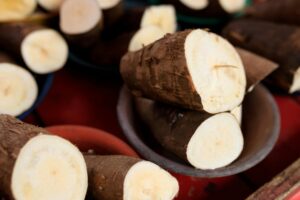Burdock Root Health Benefits Explained

Some people tend to look down at roots, flowers, seeds, and leaves, and in doing so they are quite forgetting that Mother Nature was medicine before medicine. Many modern-day medications can trace their origins to plants and herbs of all kinds.
I always say that – circumstances permitting – you should get diagnosed by a run-of-the-mill physician, but seek prognosis and balance from a holistic practitioner. Modern science can tell you what’s wrong, but sometimes it’s the more natural remedies that can help to make it right. Obviously, this is not always the case. I have nothing but respect for the medical sciences, but I believe in letting nature have its say when it is applicable. Enter burdock root.
What Is Burdock Root? Where Does Burdock Root Come From?

Sliced Burdock root.
Burdock is the common name given to the Greater Burdock plant, also known as Arctium lappa. There are other plants within the Arctium genus, but mostly when people say burdock, they mean this specific plant.
This plant originated in the northern regions of Asia and parts of Europe, although now it has migrated and is cultivated around the globe. It’s considered an invasive weed in certain areas (including the United States).
So, essentially, it’s a vegetable not unlike many other root vegetables. And much like its root brothers and sisters, it has a host of benefits and uses. The root has been traditionally used in the culinary arts, and the rest of the plant – stem, leaves, seeds, and the root as well – has been used in ancient medicines.
Burdock Root Benefits Explained
The root of the burdock has been used for centuries as a natural remedy. Over the many years of human existence, it has been used to clean the blood, to increase the flow of urine, to act as a germ-killer and fever-reducer, and to act as an overall protector of skin and scalp.
Burdock has been used in the treatment of many maladies: from the common cold and various gastrointestinal conditions, to diabetes, and even acquired immune deficiency syndrome (AIDS). Studies are still being conducted on this wondrous root, but overall the results look promising. It’s even used as a sex drive enhancer. If your libido is running low, this may be what you’ve been looking for.
You can apply this root to skin conditions of all kinds, including dry skin, eczema, acne, and even psoriasis. It has antibacterial and anti-inflammatory agents which help the body combat these conditions, and restore the skin to its former smooth and glowing glory. Whether it’s whiteheads, blackheads, redheads, or any other kind of acne-related nuisance, burdock root can help to bring it under control.
When it comes to the scalp, you can use it as a kind of tonic. Burdock root has the potential to revitalize and encourage growth among hairs which are still in the middle of their growth phase. And that includes most of your follicles, by the way. Between 80-90% of them are probably still growing, so it is in your best interest to take care of them and keep them from falling out. This is especially true if you have baldness in your genes, or if you’re simply sensing your hairline is receding more than it should. This root serves to strengthen and nourish your hair.
Burdock Root Tea Explained And Recipe

Tea being poured.
One of the easiest ways of reaping the benefits of this veggie is by making it into a burdock root tea. When prepared in the right way, you don’t miss out on any of the properties which this plant possesses. The antioxidants, the anti-inflammatory agents, the nutrients (such as minerals and vitamins) – they’re all in there. Be warned, this does not carry a flavor which resembles many herbal teas. It may take some time to grow on you, at least with some individuals. It has a very earthy taste, and it isn’t mild, but it’s also not unpleasant. Give it a few tries, and see how you feel about it.
Here is a quick and simple burdock tea recipe if you want to try your own. You need either a fresh root, or a root which has already been chopped and prepared for brewing. You’ll also need 2 cups of water and honey for taste. While honey is only used for sweetness in this recipe, it contains a myriad of benefits of its own. It contains antioxidants that rid your body of free radicals. Clean and prep the root before chopping it up. Let it dry for a few hours before roasting in a frying pan without oil. Place the roasted chunks in a teapot and add the boiled water. Let the mixture steep for 5-10 minutes before serving and adding honey to taste. And there you go – your very own burdock root tea.
Burdock Root Side Effects Explained
You need to take the good with the bad. There’s always a chance that there’ll be some adverse effects to the burdock inclusion in your health regimen or treatment. Incidentally, always get the ‘go ahead’ from your GP, herbalist, or other healthcare professional before beginning use of herbal teas for treatment of any medical condition. Sometimes there are interactions with other medications or conditions and what not. Just to be on the safe side it is always best to get a green light. Burdock root side effects include: dehydration, slower clotting of the blood, and allergic reactions of several sorts.
Where Can You Buy Burdock Root?

Farmers market.
So, where to buy burdock root? Nowadays, your best shot would probably be an online vendor, a local health food store, or even a farmers market. The latter two are better for actually seeing and getting a feel for the root before buying it, even if you end up buying it online. Health food stores can be a veritable fountain of info. I used to live close to a shop where a naturopath would come by for a couple of hours. He was available for quickie consultations and advice. Not taking patients or examining, just dispensing general knowledge and lore. I used his pro bono services on a couple of occasions, and it was useful.
If you want it fresh, it will probably have to be bought directly. If you want it aged, dried, chopped, powdered, or already in teabags, you can find those all online as well. Do NOT collect wild burdock. It resembles several plants which are toxic, and a few others which are skin-irritants and which induce allergic reactions. You should only collect the root if you’re trained and knowledgeable in this field. With this in mind, you should only buy the root from a reputable vendor or individual.
Conclusion
There is a boatload of potential in the burdock root. There are many benefits which are available for those who are interested in using the root. Whether it’s used as a form of prevention or of treatment, it has proven itself over the centuries as being a dependable and reliable source of health and wellness.
From treating an ordinary cold or run-of-the-mill stomach condition, to boosting your immunity and increasing sex drive – this is one root which is worth checking up on. For hundreds – probably thousands – of years, it has been at the service of mankind. And now, thanks to modern markets and advanced technology, it’s grown and sold all over the world. It can be obtained in a safe and easy manner. And if you’re not sure where to start using it – just try making a cup of tea!


